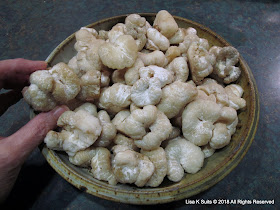I’ve known about these for a while. For whatever reason, they never really grabbed my attention. I’d found a few before, but they were way past their prime, squishy and discolored. This year, though, I found some real beauties, so I wandered a little further down the path of aborted Entoloma. These things are cool!
 |
| A bunch of them fused together |
That’s a pretty big clump. Usually they’re smaller individual units, not much bigger than styrofoam packing peanuts, which is what they look like at first glance when you find a whole bunch of them all over the place.
Click on any image to view large.
 |
| Not packing peanuts--shrimp of the woods! |
 |
| Aborted Armillaria. Also just noticed a bonus caterpillar poop at lower left, from one of the big silkworm moths. |
For a long time it was thought these were simply malformed Entoloma abortivum (but didn't anybody wonder why?). Then, in the 1970s, some guy noticed that there were Armillaria mellea cells in them (maybe spurred to study this by the fact that they kept finding both species and the malformed ones growing near each other, like, all the time), so everybody assumed the Entolomas were being parasitized by Armillaria, probably because Armillaria has a reputation for relentlessly ravaging trees. Then more people did more studies in 2001 and concluded the exact opposite—that Armillaria was being parasitized by E. abortivum. Any of these theories are fine with me.
If you go with the latest one, you might call them “abortive Entoloma.”
Inside is the same color as outside, marbled with faint pink. Why I didn't cut one in half and take a picture of it, I'll never know.
Aborted Entoloma has some great common names—“shrimp of the woods” is the one I see most often, but there is also “hunter’s heart” (I don’t get that one), “pig snoot” and “ground prune.”
So I found some nice ones this fall, and had the presence of mind to actually look around to see if I could find some honey mushrooms (Armillaria) or Entoloma nearby, and I did.
 |
| Honey mushrooms in foreground, and Entoloma abortivum next to aborted Armillaria at the back. |
 |
| Entoloma abortivum with aborted Armillaria |
 |
| Entoloma abortivum has dropped its pink spores on the cap beneath it. |
The Entolomas I found were in the company of A. gallica.
 |
| Armillaria gallica, with characteristic cap scales. |
While we’re on the subject, both the Armillaria and this particular Entoloma species are edible, but I have not eaten the Entoloma because it scares me. There’s some nasty poisonous Entolomas out there.
Hopefully I’ve lost some of my audience now by boring them with facts so they won’t be reading the next part (read: “starting to hunt for aborted Entolomas now and finding my spots”), which is that these things are delicious! Might be my new favorite! I poked around looking up suggestions on how to prepare them, and ForagerChef said they’re best when caramelized, so I did that. I just kept eating them as they came out of the pan. They’re nutty and sweet, with a kind of bouncy texture, a little grainy--like shrimp. Another mushroom that isn’t really anything like what you think of when you think of eating mushrooms.
That’s a big beautiful bowl of raw freshly rinsed ones.



